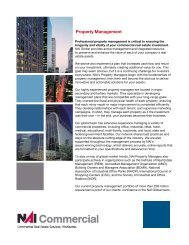2010 Global Market Report - NAI Commercial Real Estate
2010 Global Market Report - NAI Commercial Real Estate
2010 Global Market Report - NAI Commercial Real Estate
- No tags were found...
Create successful ePaper yourself
Turn your PDF publications into a flip-book with our unique Google optimized e-Paper software.
levels in Noida (near Delhi) were 40%. The new government and falling interest rates inthe second quarter of 2009 have improved local business sentiment in India. Butdespite improved confidence, office rentals slid in major cities as tenants moved tocheaper locations or upgraded at no cost. <strong>Commercial</strong> property markets will likelyremain soft in the short- to medium-term. Landlords in secondary office locations willstruggle with the consequences of overbuilding and will increase tenant incentives. Thecommercial market will follow the growth spurt of the residential sector, but slowly.On the industrial front, market players are positioning themselves for leadership inlogistics and manufacturing platforms. Higher-quality buildings and infrastructureare desperately needed but challenges remain in land acquisition and aggregatingland assemblage.IndonesiaWith a strong domestic economy and less dependence on foreign investment andcapital flows, Indonesia has weathered the storm well. Projections for GDP growth in2009 and <strong>2010</strong> are 4% and 4.8%, respectively. Estimates for consumer price increasesin 2009 and <strong>2010</strong> are 5% and 6.2%, respectively.Many multinational companies have put expansion plans on hold. Investment yields inIndonesia are 7-9%, but there very few transactions closed in the last 12 months. Theoffice rental rate in Jakarta remained stable, even as the office vacancy rate will increaseto 15% by year-end <strong>2010</strong>.Rental prices fell due to weak economic growth. Supply is predicted to be high for thenext two years (around 290,000 SM during 2009-<strong>2010</strong>). As retailers consolidate stores,absorption will be negative.JapanHeavy investment in residential and commercial property markets in the last few years hasled to extraordinary buying opportunities due to the current lack of liquidity. Projections forGDP growth in 2009 and <strong>2010</strong> are -5.4% and 1.7%, respectively. Estimates for consumerprice increases in 2009 and <strong>2010</strong> are -1.1% and -0.8%, respectively.The property sector has been badly bruised, with developers and managers accountingfor eight of the 10 biggest bankruptcies of listed Japanese companies this year. Manylarge investment funds are proposing to start buying Japanese property in the first halfof <strong>2010</strong> when prices are expected to bottom. However, to date there has not been asmuch distress in the market as most expected. One reason is that the leniency ofJapanese banks allows borrowers to refinance rather than forcing liquidation.<strong>Commercial</strong> land prices in Japan fell 4.7% to a three-year low in 2008, with the declineincreasing to 5.4% in Tokyo, Osaka and Nagoya. Office vacancies in Tokyo's mainbusiness districts increased for the 17th month in a row in June 2009 to 7.25%.Financially strong office tenants have been upgrading their locations to better buildingswithout increasing rents.<strong>2010</strong> <strong>Global</strong> <strong>Market</strong> <strong>Report</strong> ■ www.naiglobal.com18





